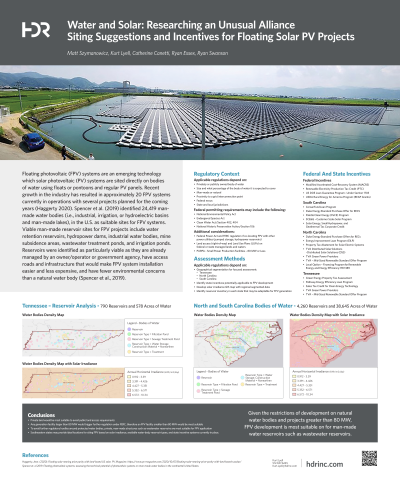Back

Grid Integration & Electrification
A29 - Water and Solar - Researching an Unusual Alliance
Tuesday, September 20, 2022
4:30 PM – 5:30 PM
Location: ACC Arena Foyer/Hall A


Matthew Szymanowicz
Environmental Project Manager
HDR Inc.
Mukilteo, Washington, United States
Kurt A. Lyell
Solar Program Manager
HDR
Round Rock, Texas, United States
Invited Poster Presenter(s)
Overview - Renewable energy deployment goals are needed to drive increased penetration of distributed solar generation. With usable land becoming increasingly expensive, installing solar panels on natural/artificial water bodies such as lakes, reservoirs could alleviate this impact on land-use constraints.
Impact - This session will cover the following aspects:
(1) Benefits and challenges with floating solar deployment
(2) Regional consideration for developing floating solar projects
(3) Land Use Plans (LUPs) applicability to utility-scale solar development and how it ties in with Floating Solar Photovoltaic (FPV)
(4) PURPA and Qualifying Facility qualification criteria to sell energy to public utilities
(5) Selection criteria for siting of FPV on Waters of the United States Vs Artificial Water Bodies
(6) Federal and State Incentives for Solar Development that would impact the deployment
Innovation - Cross collaboration of the solar industry with water-wastewater industry, and hydropower development, as well as challenging utility-scale solar developers to partner with behind-the- meter "water-owners" to develop floating solar photovoltaics.
Impact - This session will cover the following aspects:
(1) Benefits and challenges with floating solar deployment
(2) Regional consideration for developing floating solar projects
(3) Land Use Plans (LUPs) applicability to utility-scale solar development and how it ties in with Floating Solar Photovoltaic (FPV)
(4) PURPA and Qualifying Facility qualification criteria to sell energy to public utilities
(5) Selection criteria for siting of FPV on Waters of the United States Vs Artificial Water Bodies
(6) Federal and State Incentives for Solar Development that would impact the deployment
Innovation - Cross collaboration of the solar industry with water-wastewater industry, and hydropower development, as well as challenging utility-scale solar developers to partner with behind-the- meter "water-owners" to develop floating solar photovoltaics.
